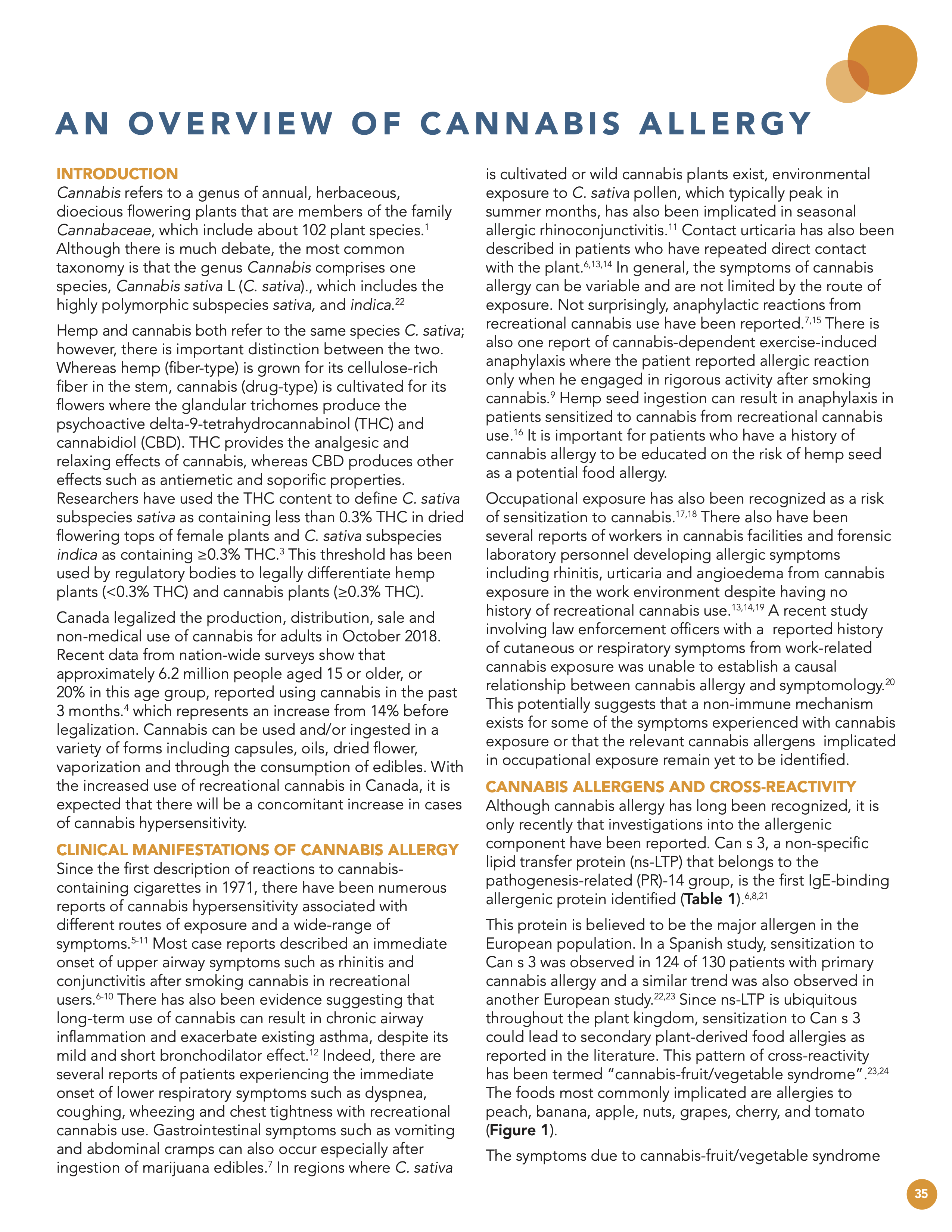An Overview of Cannabis Allergy
DOI:
https://doi.org/10.58931/cait.2022.2234Abstract
Cannabis refers to a genus of annual, herbaceous, dioecious flowering plants that are members of the family Cannabaceae, which include about 102 plant species.Although there is much debate, the most common taxonomy is that the genus Cannabis comprises one species, Cannabis sativa L (C. sativa)., which includes the highly polymorphic subspecies sativa, and indica. Hemp and cannabis both refer to the same species C. sativa; however, there is important distinction between the two. Whereas hemp (fiber-type) is grown for its cellulose-rich fiber in the stem, cannabis (drug-type) is cultivated for its flowers where the glandular trichomes produce the psychoactive delta-9-tetrahydrocannabinol (THC) and cannabidiol (CBD). THC provides the analgesic and relaxing effects of cannabis, whereas CBD produces other effects such as antiemetic and soporific properties. Researchers have used the THC content to define C. sativa subspecies sativa as containing less than 0.3% THC in dried flowering tops of female plants and C. sativa subspecies indicaas containing ≥0.3% THC.This threshold has been used by regulatory bodies to legally differentiate hemp plants (<0.3% THC) and cannabis plants (≥0.3% THC). Canada legalized the production, distribution, sale and non-medical use of cannabis for adults in October 2018. Recent data from nation-wide surveys show that approximately 6.2 million people aged 15 or older, or 20% in this age group, reported using cannabis in the past 3 months. which represents an increase from 14% before legalization. Cannabis can be used and/or ingested in a variety of forms including capsules, oils, dried flower, vaporization and through the consumption of edibles. With the increased use of recreational cannabis in Canada, it is expected that there will be a concomitant increase in cases of cannabis hypersensitivity.
References
Ren G, Zhang X, Li Y, et al. Large-scale whole-genome resequencing unravels the domestication history of Cannabis sativa. Sci Adv. 2021;7(29).
McPartland JM. Cannabis Systematics at the Levels of Family, Genus, and Species. Cannabis Cannabinoid Res. 2018;3(1):203-212.
Small E, Cronquist A. A practical and natural taxonomy for Cannabis. Taxon. 1976:405-435.
Rotermann M. Looking back from 2020, how cannabis use and related behaviours changed in Canada. Health reports. 2021;32 4:3-14.
Liskow B, Liss JL, Parker CW. Allergy to marihuana. Ann Intern Med. 1971;75(4):571-573.
Gamboa P, Sanchez-Monge R, Sanz ML, Palacin A, Salcedo G, Diaz-Perales A. Sensitization to Cannabis sativa caused by a novel allergenic lipid transfer protein, Can s 3. J Allergy Clin Immunol. 2007;120(6):1459-1460.
Tessmer A, Berlin N, Sussman G, Leader N, Chung EC, Beezhold D. Hypersensitivity reactions to marijuana. Ann Allergy Asthma Immunol. 2012;108(4):282-284.
Larramendi CH, Lopez-Matas MA, Ferrer A, et al. Prevalence of sensitization to Cannabis sativa. Lipid-transfer and thaumatin-like proteins are relevant allergens. Int Arch Allergy Immunol. 2013;162(2):115-122.
Wong DD, Abbas KF, Grunberg RW, Sussman G. Cannabis Allergy: A Melting Pot of Clinical Manifestations. The Journal of Allergy and Clinical Immunology. 2018;141.
Decuyper, II, Faber MA, Lapeere H, et al. Cannabis allergy: A diagnostic challenge. Allergy. 2018;73(9):1911-1914.
Stokes JR, Hartel R, Ford LB, Casale TB. Cannabis (hemp) positive skin tests and respiratory symptoms. Ann Allergy Asthma Immunol. 2000;85(3):238-240.
Tashkin DP. Airway effects of marijuana, cocaine, and other inhaled illicit agents. Curr Opin Pulm Med. 2001;7(2):43-61.
Williams C, Thompstone J, Wilkinson M. Work-related contact urticaria to Cannabis sativa. Contact Dermatitis. 2008;58(1):62-63.
Rojas Perez-Ezquerra P, Sanchez-Morillas L, Davila-Ferandez G, et al. Contact urticaria to Cannabis sativa due to a lipid transfer protein (LTP). Allergol Immunopathol (Madr). 2015;43(2):231-233.
Perez JA. Allergic reaction associated with intravenous marijuana use. J Emerg Med. 2000;18(2):260-261.
Stadtmauer G, Beyer K, Bardina L, Sicherer SH. Anaphylaxis to ingestion of hempseed (Cannabis sativa). J Allergy Clin Immunol. 2003;112(1):216-217.
Decuyper II, Green BJ, Sussman GL, et al. Occupational Allergies to Cannabis. J Allergy Clin Immunol Pract. 2020;8(10):3331-3338.
Sussman GL, Beezhold DH, Cohn JR, Silvers WS, Zeiger JS, Nayak AP. Cannabis: An Emerging Occupational Allergen? Ann Work Expo Health. 2020;64(7):679-682.
Herzinger T, Schopf P, Przybilla B, Rueff F. IgE-mediated hypersensitivity reactions to cannabis in laboratory personnel. Int Arch Allergy Immunol. 2011;156(4):423-426.
Decuyper, II, Van Gasse A, Faber MA, et al. Occupational cannabis exposure and allergy risks. Occup Environ Med. 2019;76(2):78-82.
de Larramendi CH, Carnes J, Garcia-Abujeta JL, et al. Sensitization and allergy to Cannabis sativa leaves in a population of tomato (Lycopersicon esculentum)-sensitized patients. Int Arch Allergy Immunol. 2008;146(3):195-202.
Armentia A, Herrero M, Martin-Armentia B, Rihs HP, Postigo I, Martinez-Quesada J. Molecular diagnosis in cannabis allergy. J Allergy Clin Immunol Pract. 2014;2(3):351-352.
Ebo DG, Swerts S, Sabato V, et al. New food allergies in a European non-Mediterranean region: is Cannabis sativa to blame? Int Arch Allergy Immunol. 2013;161(3):220-228.
Decuyper, II, Van Gasse AL, Cop N, et al. Cannabis sativa allergy: looking through the fog. Allergy. 2017;72(2):201-206.
Faber M, Van Gasse A, Sabato V, et al. Marihuana allergy: beyond the joint. J Investig Allergol Clin Immunol. 2015;25(1):70-72.
Ebo DG, Decuyper, II, Rihs HP, et al. IgE-binding and mast cell-activating capacity of the homologue of the major birch pollen allergen and profilin from Cannabis sativa. J Allergy Clin Immunol Pract. 2021;9(6):2509-2512 e2503.
Nayak AP, Green BJ, Sussman G, et al. Characterization of Cannabis sativa allergens. Ann Allergy Asthma Immunol. 2013;111(1):32-37.
Lo SCR, Abbaslou M, Abbas KF, Kobric D, Silvers WS, Sussman G. Cannabis Hypersensitivity Prevalence and Presentation: A Survey-based Study of an Allergic Adult Population in a Toronto Clinic at Onset of Canadian Legalization of Recreational Marijuana. The Journal of Allergy and Clinical Immunology. 2020;145.
Morelli HP, Thorpe C, Decuyper II, et al. Non-specific Lipid Transfer Protein (Can s 3) Is a Relevant Cannabis Allergen in North America. The Journal of Allergy and Clinical Immunology. 2021;147.
Decuyper, II, Van Gasse AL, Faber MA, et al. Exploring the Diagnosis and Profile of Cannabis Allergy. J Allergy Clin Immunol Pract. 2019;7(3):983-989 e985.
Engler DB, Malick AA, Saraf S, Dargel LA. Severe Marijuana Allergy Controlled with Omalizumab. The Journal of Allergy and Clinical Immunology. 2013;131.
Kumar R, Gupta N. A case of bronchial asthma and allergic rhinitis exacerbated during Cannabis pollination and subsequently controlled by subcutaneous immunotherapy. Indian Journal of Allergy, Asthma and Immunology. 2013;27:143.

